CN7026 Cloud Computing Assignment Sample
Introduction
This report discusses about the travel airline management system based on cloud services. The main objective of this project is to minimize the workload of the airport staff by performing the ticket booking activities using a web application. This also helps the customers to view the vacant seats on a particular day, ticket status of their booking.
This application helps the airline companies to increase the business opportunities by analyzing the past passenger data. They can provide offers based on the travel history of the passenger and increase the number of flights for a particular destination which is frequently travelled by most number of passengers. The travel agencies who book tickets for the passengers can increase the number of bookings by fast services using this application. The passengers or travel agencies can pay the flight through online payment services.
Project Planning
The project planning takes place after the project has been approved. The requirements of the project have been gathered from the stake holders and the requirements are studied with cost and schedule. The feasibility study has been done with functional and non functional requirements. The planning phase acts as the model for executing the project.
This phase defines the set of deliverables of the project. The project milestones are also defined at this stage. The set of milestones of this project is given as follows:
- Registration and Login module
There are three different types of users here. The admin staff of the airline company who performs all the administrative operations on the application. The passengers who can view and book the airline tickets. The ticket booking agency that reserves tickets for the passengers. The passengers and the booking agency should create the account using registration page then they can access the application using the username and password given during their registration
- The Admin module
The admin staff of the airline company can view the flight details, passenger details and search for flights on a particular day. The admin staff can also book or cancel tickets for the passengers with phone call or in person.
- Passenger Module
The passenger can view the flight details for a particular date and book or cancel tickets. The passenger uses the login account for performing these actions.
- Ticket Booking agency Module
The booking agency can have slightly different role as a passenger. They also can book or cancel ticket for the passengers. But the passengers have to extra service fee to the agency.
Cloud Architecture and Solutions
Requirements Gathering
The software requirements of the project have been gathered from the stakeholders. After gathering the requirements, the suitable cloud service should be identified. While choosing the cloud services, the set of parameters like availability, security, recovery and backup plans (POCATILU, 2010). The requirements are analyzed using the functional and non functional requirements.
Functional requirements
Following are the functional requirements of this project:
- User Login Account
- Registration of user accounts
- Checking the availability of tickets
- Reservation or cancelling tickets
- Ticket Status
Non Functional requirements
- Availability – how much time the services are available
- Scalability – how much resources can increased or decreased
- Interoperable services – how the services can be moved to different standards.
- Security – how much the data and services are secure
- Performance – how well the services work
- Response Time – how much time it takes for giving response
- Fault Tolerance – how long the services work in case of errors (Villegas & Sadjadi, 2011)
Choice of Cloud Platform
By analyzing the requirements of the airline management project, the suitable cloud service for this project is Software as a Service (SaaS). There are three types of cloud services. IaaS leases the infrastructure for the services;
PaaS leases the platform for the services and the SaaS leases software for the services. Saas is a cloud computing service where the customers can lease the software and other processing resources for their business functions from a third party cloud service provider through the internet (Kim, Jang, & Yang, 2019).
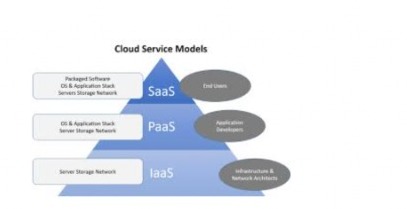
Using the SaaS cloud service, the users can be able access the sophisticated applications which is needed for the business functions. For using this service, the customers pay only for what services they use. The users do not need to install any software to run applications.
These services can any device like computers or mobile phones. The application can be accessed from anywhere as the processing storage is done in the cloud service. There is no data lose even if the user computer or mobile fails as all the data are stored in the cloud storage (Microsoft Azure , 2020).
Choice of Data centre and Standards
There are three types of data centres public, private and hybrid clouds. Based on the requirements of the project, the hybrid cloud is chosen as it has more security than the other clouds. The passenger details have to maintain in the storage in secure manner without leaking the details.
When using the public cloud, there is a possibility of unauthorized access of passenger details by the other users of the public cloud. The hybrid cloud is a combination of private and public cloud
The private cloud is also referred as an internal cloud which may be situated inside the enterprise. These data centres are accessed using the internal network of the enterprise. This provides security to the data and applications that are residing in it. For storing the passenger details private cloud can be used which are accessed only by the airport staffs.
The public cloud service can be used to run the application functions of the passenger and the travel booking agency. The payment process will be done using the secure cloud services.
The hybrid cloud combines the features of both the public and private cloud at the same time eliminating the disadvantages. A virtual private network can be used to provide security from the internal private network to the public network where the application is running.
Cloud System Architecture for Travel Airline Management System
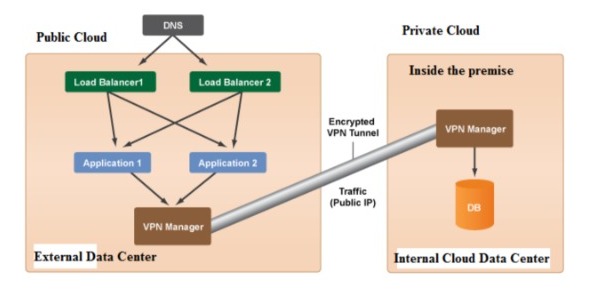
This cloud architecture for the travel airline management system is given above. The architecture is divided in to two components. One side at the internal network of the airline which has a database for storing the passenger details which is to be secure. The other side is the public cloud where the services of the application are running. This application is accessed by the passengers and the travel agencies for performing the intended operations.
The application can use by login the application after registering into the application. The flight details and ticket status can be viewed from the public cloud by getting the data from the private cloud in the airport premise through the virtual private network. The VPN is a private network channel used only by the airport network for accessing the data into and from the cloud application at the public cloud.
This VPN channel cannot be accessed by any other networks. As the passenger detail have sensitive information like personal details, travel history and payment details, it responsibility of the organization handling these details to provide security.
Microsoft Azure Cloud pricing
The cost of this project varies based on the number of factors. Auto scaling can be used to increase or decrease the resource. As it is enough to pay what we use. Here we need to sum up the cost of each service. The cost of the web server, database and other infrastructure services are added up. And the cost for this project is given as follows
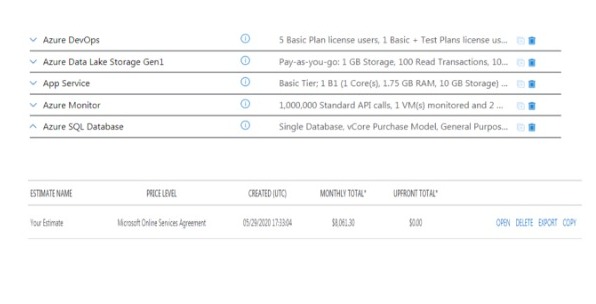
Implementation using MS Azure Cloud
Load balancer
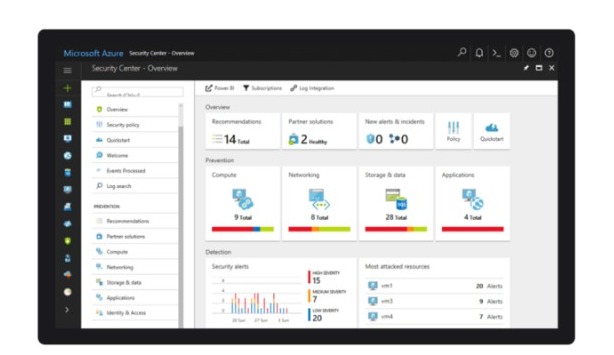
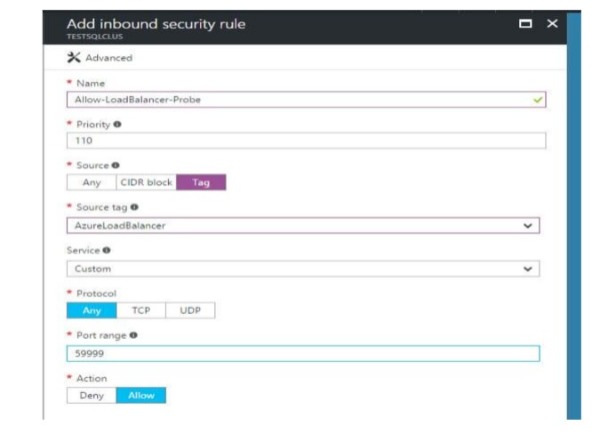
Analysis and Reflection
The cloud architecture of travel airline management system has been discussed in the previous section. This architecture can be used efficiently by storing the sensitive passenger information in the on premise cloud data centre and the web service for viewing the flight details can be accessed from the public cloud. The cloud service providers should ensure the availability, performance and the fault tolerance by setting a Service Level Agreement (SLA).
The location of cloud where the application is running should be within the country for security purposes. The provider should handle the workloads in order to maintain the availability of the services. There should be monitor to track the workload if there are more number of usage, the extra resources should be added to handle the peak workloads. The remote administration and resource management services should be enabled by the cloud provider.
Conclusion
Thus the cloud architecture for the travel airline management system has been designed and implemented using the Microsoft Azure. The milestones and deliverables of the project have been discussed. The type of cloud service and data center also defined with justifications. The cloud architecture for the project has been designed and some modules of the project are implemented. And the project is analyzed for future maintenance.
References
Kim, S. H., Jang, S. Y., & Yang, K. H. ,2019. Analysis of the Determinants of Software‐as‐a‐Service Adoption in Small Businesses: Risks, Benefits, and Organizational and Environmental Factors. Journal of Small Business Management , 303-325.
Microsoft Azure . ,2020. What is SaaS? https://azure.microsoft.com/en-in/overview/what-is-saas/ , 1-1.
POCATILU, P.,2010. Project management for cloud computing. Oeconomics of Knowledge , 16-22.
Villegas, D., & Sadjadi, S. M. ,2011. Mapping Non-Functional Requirements to Cloud Applications. Proceedings of the 23rd International Conference on Software Engineering & Knowledge Engineering (pp. 1-7). USA.
24/7 Chat Support | Get A+ Grade | Written by Top-Notch Subject Experts | 20% Off 1st Order |
Know more about UniqueSubmission’s other writing services:

